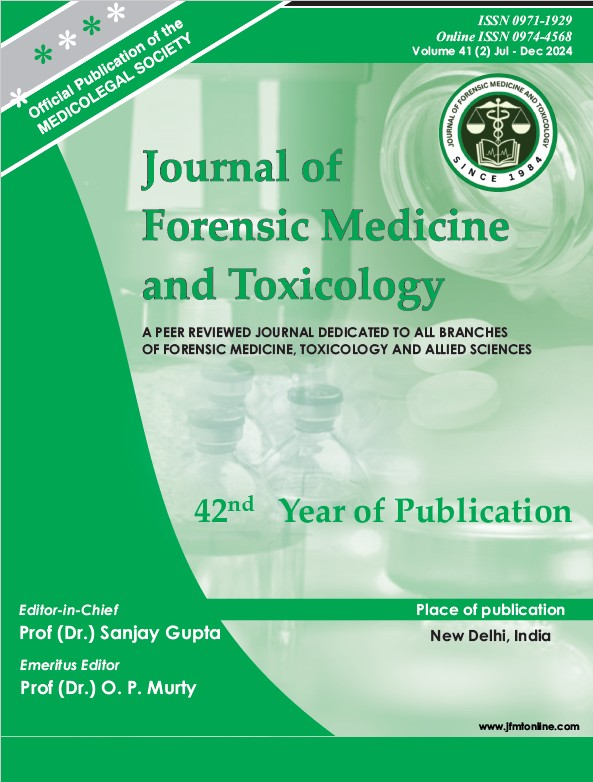Identifying the barriers for the decline of Eye donation among the post-mortem cases in SCBMCH, Cuttack.
DOI:
https://doi.org/10.48165/jfmt.2025.42.3.3Keywords:
Corneal Blindness, Corneal transplant, Corneal donation, Disfigurement.Abstract
Globally blindness is a public health problem. Corneal blindness is the third leading cause of blindness worldwide after cataract and glaucoma. Corneal transplantation is the most frequently performed type of transplant worldwide. Cadaver donors are the only source of donor corneas. The need therefore is to educate the masses about eye donation in an effort to increase the procurement of corneas by eliminating the prevailing misbeliefs and misconceptions. The study was done to identify the hindrances and misconceptions and steps to overcome them. The study was done on 1030 participants who were the next of the kin of the deceased autopsied in the central mortuary of SCB MCH, Cuttack, Odisha. Only about a third of the total study population had heard about corneal donation, and still lesser had some knowledge regarding it. Among the willing, the males outnumbered the females; and the urban population was keener to donate corneas. The Sikh population were more willing than the Hindus and Muslims. Majority of the willing considered corneal donation as noble act. The rural population was more familiar on corneal donation. Print media was the major source of information and least was from news media. Conclusion: Disfigurement was the most common misconception, whereas ignorance was the most common hindrance in corneal donation. Educating the children on organ donation from school level can develop the long-term counselling and constant sensitization benefits when they grow up as an adult.
Downloads
References
Synnott A. The body social: Symbolism, self, and society. London: Routledge; 1993.
Gupta PC, Duggal M, Jamir L, Sharma D, Kankaria A, Sathyanath S, et al. Knowledge and attitude toward corneal donation among high school children in northern India. Cornea. 2017 May 1;36(5):611–616.
Gain P, Jullienne R, He Z, Aldossary M, Acquart S, Cognasse F, et al. Global survey of corneal transplantation and eye banking. JAMA Ophthalmol. 2016 Feb 1;134(2):167–173.
Sharma B, Shrivastava U, Kumar K, Baghel R, Khan F, Kulkarni S. Eye donation awareness and conversion rate in hospital cornea retrieval programme in a tertiary hospital of central India. J Clin Diagn Res (JCDR). 2017 Aug;11(8):NC12–NC15.
Singh MM, Rahi M, Pagare D, Ingle GK. Medical students’ perception on eye donation in Delhi. Indian J Ophthalmol. 2007 Jan 1;55(1):49–52.
DOMS LP. Corneal transplants—an overview with an emphasis on legal aspects and current scenario in Mauritius. Int J Med Update. 2007 Jul;2(2):1–6.
Tandon R, Verma K, Vanathi M, Pandey RM, Vajpayee RB. Factors affecting eye donation from postmortem cases in a tertiary care hospital. Cornea. 2004 Aug 1;23(6):597–601.
Dandona R, Dandona L, Naduvilath TJ, McCarty CA, Rao GN. Awareness of eye donation in an urban population in India. Aust N Z J Ophthalmol. 1999 Jun;27(3–4):166–169.
Lawlor M, Kerridge I. Anything but the eyes: culture, identity, and the selective refusal of corneal donation. Transplant. 2011 Dec 15;92(11):1188–1190.
Horton RL, Horton PJ. A model of willingness to become a potential organ donor. Soc Sci Med. 1991 Jan 1;33(9):1037–1051.
Regional Center for Development Cooperation [Internet]. Rcdcindia.org. 2025 [cited 2025 Jan 18]. Available from: https://rcdcindia.org/places/bhubaneswar-beyond/
Tsigkos D, Tzelepi A, Kopsini D, Manolakou D, Konistis E, Palioura S. Interactive online survey raises awareness about cornea donation. BMJ Open Ophthalmol. 2020 Feb 1;5(1):e000285.
Yew YW, Saw SM, Pan JC, Shen HM, Lwin M, Yew MS, et al. Knowledge and beliefs on corneal donation in Singapore adults. Br J Ophthalmol. 2005 Jul 1;89(7):835–840.
Chu T, Wang LN, Yu H, Zhang RY. Awareness of cornea donation of registered tissue donors in Nanjing. Chin Med Sci J. 2013 Mar 1;28(1):20–27.




